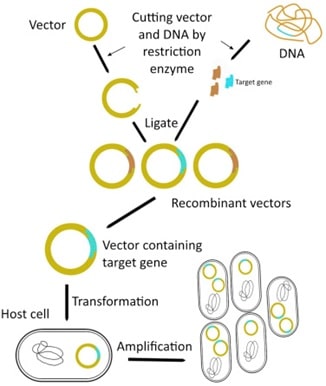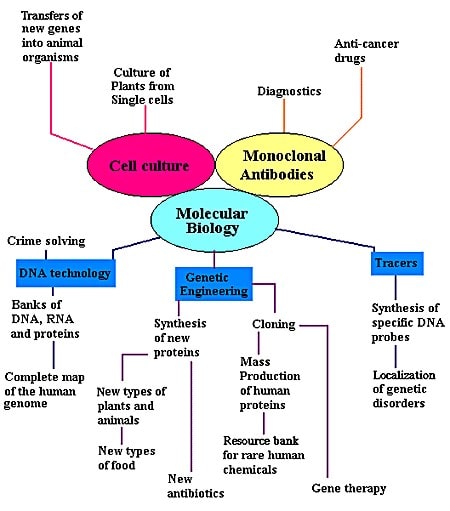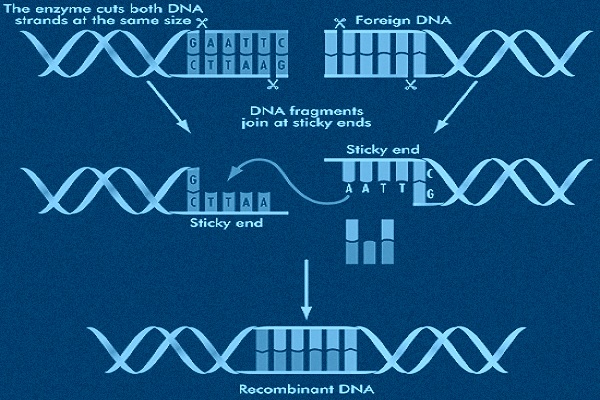Recombinant DNA Technology Assignment Help
DNA is the genetic hereditary material which every species presents on this planet possess and pass it to the next generation. Recombinant DNA technology is the technique of ligating the two DNA molecules of different species and it is then introduced into the bacterial cells or specifically vectors, that would help to carry the recombinant into the host genome. The combinations produced can then be used in the various fields of science, husbandry, drugs and industrial works. The knowledge of this technique was first enlightened by Peter Loban. He was the student of Professor Dale Kaiser in the Biochemistry Department at Stanford University Medical School (Kayser and Müller, 2005). The first drug that was created and registered by the use of recombinant DNA technology was human insulin. It was created by Genentech and then got accredited by Eli Lily and the company (Gawad, Tauro and Kolhe, 2016) The recombinant DNA technology involves blending of two processes i.e., Cloning and DNA sequencing. Cloning is the technique of producing multiple copies of the sequence of interest and when a particular clone is selected from the obtained library of clones, then the sequence of the particular region of interest can be identified and variations can be thus noted down to know whether the particular sequence is mutated or not. Mutation can sometimes produce risk or sometimes induce protection in relation to the disease. Once the clone that is best suitable for our needs is selected, it is then inserted into the DNA vectors (J.F. Griffiths, 2019). Most frequently used DNA vectors are-
- Plasmids
- Cosmids
- Phage (λ)
- Bacterial Artificial Chromosomes (BAC)
- Yeast Artificial Chromosomes (YAC)
- Mammalian Artificial Chromosomes (MAC)
Each modified vector has-
- An origin of replication (ori)
- A cloning site (this is the site at which cut can be made, to induce foreign DNA and the cut induced neither interrupts the replication nor it leads to inactivation of the markers that are essential for the replication machinery)
- A chief marker (this is a gene which thus provides resistance from antibiotics.
Recombinant DNA Technology Assignment Help By Online Tutoring and Guided Sessions from AssignmentHelp.Net
The vector to choose depends upon its size and applications
|
Vector |
Basis |
Size limit of the insert |
Application |
|
Plasmid |
Extrachromosomal DNA that replicates in bacterial cell naturally and is generally circular in form. |
≤ 10 kb |
Subcloning and manipulation, cloning of cDNA, and various expression-based assays. |
|
Phage |
Bacteriophage λ |
5 – 20 kb |
Cloning of genomic and cDNA and in construction of expression libraries |
|
Cosmid |
One more bacteriophage with λ cos site i.e. combines features of both phages as well as plasmids. |
35 – 45 kb |
Construction of Genomic libraries |
|
BAC |
Escherichia Coli F factor plasmid |
75 - 300 kb |
Large genomes could be analysed |
|
YAC |
Contains centromere, telomere and self- replicating sequence of Saccharomyces Cerevisiae |
100 – 1000 kb (1 Mb) |
Large genomes could be analysed and use of YAC transgenic mice |
|
MAC |
Consists of the mammalian centromere, telomere and origin of replication. |
100 kb to > 1Mb |
Under progress for its use in human gene therapy and animal biotechnology |
[ Adapted and modified from B. Mullis, 1990]
In ancient times, this technology was nothing but a mere imagination of enhancing certain features of a species by having control upon the expression of targetable genes. With the asset of this technology, it has become possible to modify the activity to certain genes and manufacturing of proteins, hormones, that are needed to overcome health problems and nutritional purposes with desired safety and affordable ranges. Thus, it helps in the improvement of health, enhancement of resources of food and offers resistance to harsh environmental factors. With the help of this technique, it has become possible for plants to have augmentin pest resistance which helped in gaining yield in the food production and showed better chances of survival. Pharmacy companies have also attained approvals for bringing up of proficient and effective drugs by using the recombinant technique. Thus, the technology along with gene therapy can lead to modifications in the genome which would help to prevent and treat stern diseases (Khan et al., 2016).
Steps involved in the making of recombinant DNA: -
- Isolate the DNA- A particular fragment of DNA is isolated by disrupting the cell wall with the help of detergents and degrading of proteins and RNAs with the help of phenol and RNase, parting DNA from all.
- DNA can be fragmented into larger or smaller sizes depending upon the requirement. The cut can be made either by mechanical shearing or by with the help of restriction enzymes. The restriction enzymes are endonucleases that have the ability to recognize certain nucleotide arrangements thus generating sticky or blunt ends. These enzymes are usually palindromic and are commercially available.
- After the isolation and cutting of the DNA of interest and the vector DNA, it is now essential to ligate them. For this, the two DNAs are to be mixed in the same tube. If the cut, on both DNAs, was made by using the same restriction enzyme, then, it would have lead to the production of sticky ends which now will be ligated. The process of ligation is carried out by an enzyme called DNA ligase. It is a type of glue that holds up the two DNAs together leading to the creation of phosphodiester bond.
- Amplification of DNA can be done by transforming it into the bacterial strain which on replication would pass the recombinant material to the daughter cells and so on it gets amplified.
- Choosing of vectors: The vectors can be chosen on the basis of the requirements that can be fulfilled by them and that are-
- It must be capable enough to replicate in the host cell
- It must have particular RE sites so that DNA of interest can be inserted
- It must be smaller in size
- It must be easily isolated
- It must have a selectable marker that could tell about which cells in the host have that recombinant DNA (Sivabio.50webs.com,2019).

(V. Pham, 2018)
Gene cloning is the process in which the DNA of interest is ligated with the vector strand and is inserted into the bacterium which then multiplies in the host itself leading to the production of similar copies of the self as well as the gene that it is carrying. Upon the division of host’s cells, the replicas of recombinant DNA molecules are carried away to the daughter cells leading to a continuation of the replicas of the vectors. Later on, after when the production of several numbers of copies, a clone consisting of similar host cells would be obtained, hence, the recombinant molecule carrying the gene of interest is now said to be as cloned (Brown, 2010).
APPLICATIONS:
- The vectors that are used in the recombinant DNA technology are used in the production of viral vaccines and for gene therapy. Gene therapy can be implicated in a human having acquired or those who are carrying genetic diseases probably AIDS. Thus, it can be categorized into somatic gene therapy or the germline gene therapy.
- Recombinant DNA technology has its implication in the production of the recombinant antibodies. E. coli having a combination of phage along with the gene libraries containing antibodies within them are sole of interest in the creation of antibodies.
- The micro-organisms that occur naturally in the environment are used in identification and filtration of the waste before it is disposed of in the grounds.
- Bioremediation is a program which uses microorganisms to filter the air, pathways of lands, lakes and seaways. Recombinant technology thus helps to eradicate the problems very efficiently.
- The technology is helping in the development of the ‘bioluminescores’ that produces light incoming contact with the chemical pollutants (Gawad, Tauro and Kolhe, 2016)
- Mammalian cells, can be used as bacterial hosts, be modified to produce various monoclonal antibodies, growth factor receptors, enzymes, etc. Mammalian cells serve as better host vectors than bacterial cells as they have proper folding of recombinant proteins with correct disulfide bond formation, carboxylation, phosphorylation, etc. (Bronzino, 2006)
- Recombinant technology has to lead to the increased production of cellulases as these help in the conversion of the cellulose-containing biomass into the glucose and other by-products. Nature has given microorganisms the potential to yield cellulase which functions as hydrolysing cellulose (Singh et al., 2019)
- The diagram below illustrates that every field of science is involved in using this technique and is benefited by the production of its relative substituents.

Here are some objectives of recombinant DNA molecules :
- a) to obtain large number of copies of specific DNA fragments,
- b) for recovery of large quantities of the protein which produced by the concerned gene,
- c) to integrate the gene in question into the chromosome of a target organism where it expresses itself.
Cloned DNA segments which have vectors, called DNA inserts, are then introduced into a appropriate organism, basically bacterium; that organism is called the host, and the process is called transformation.
The steps concerned with transformation of a appropriate host with recombinant DNA, and the process of the transformed cells is called DNA cloning or gene cloning.


The main topics which are considered in Recombinant DNA Technology are discussed in brief as follows:
(Sivabio.50webs.com, 2019).
References
Mullis, K. (1990). Recombinant DNA Technology and molecular cloning. Scientific American, 262(36), pp.180-231.
Bronzino, J. (2006). Tissue engineering and artificial organs. 1st ed. Boca Raton, p.1304.
Brown, T. (n.d.). Gene cloning and DNA analysis. 6th ed. UK: Wiley-Blackwell.
Gawad, J., Tauro, S. and Kolhe, S. (2016). Recombinant DNA Technology: Short Communication. International Journal of Pharmacovigilance, [online] 1(2), pp.1-3. Available at: semanticscholar.org.
Kayser, O. and Müller, R. (2005). A Primer on Pharmaceutical Biotechnology and Industrial Applications. Pharmaceutical Biotechnology, Drug Discovery and Clinical Applications. Wiley-VCH-Weinheim, 7.
Khan, S., Ullah, M., Siddique, R., Nabi, G., Manan, S., Yousaf, M. and Hou, H. (2016). Role of Recombinant DNA Technology to Improve Life. International Journal of Genomics, [online] 2016, pp.1-14. Available at: https://www.hindawi.com/journals/ijg/2016/2405954/abs/.
J.F. Griffiths, A. (2019). Recombinant DNA - Creating the clone. [online] Encyclopedia Britannica. Available at: https://www.britannica.com/science/recombinant-DNA-technology/Creating-the-clone [Accessed 20 Jul. 2019].
Singh, G., Patel, A., Gupta, A., Gupta, D. and Mishra, V. (2019). Current Advancements in Recombinant Technology for Industrial Production of Cellulases: Part-II. Springer link, [online] pp.177-201. Available at: https://link.springer.com/chapter/10.1007/978-3-030-14726-6_11 [Accessed 20 Jul. 2019].
Sivabio.50webs.com. (2019). STEPS IN DNA CLONING. [online] Available at http://sivabio.50webs.com/dnacloning.htm [Accessed 20 Jul. 2019].
- Pham, P. (2018). Recombinant DNA Technology - an overview | ScienceDirect Topics. [online] Sciencedirect.com. Available at: https://www.sciencedirect.com/topics/biochemistry-genetics-and-molecular-biology/recombinant-dna-technology [Accessed 20 Jul. 2019].
To submit Recombinant DNA Technology assignment click here
Recombinant DNA Technology Assignment Help | Recombinant DNA Technology Homework Help | Recombinant DNA Technology Online Help | Biochemical Engineering | Biological Engineering | Biological Chemistry | Science And Biotechnology | Application Of Biotechnology | Applied Biology | Organisms | Biology Research Lab | Enzymes | Online Tutoring | Biochemical Engineering | Carbohydrates | Lipids | Proteins | Nucleic Acids | DNA | Bioreactors | Bioprocessing | Applied Biochemistry And Biotechnology | Applied Chemical Technology | Genetics engineering | Biochemical Assignment Help | Biotechnology Assignment Help | Cell Biology | Biochemical Processes | Biochemical Nutrition | Molecular Biology


